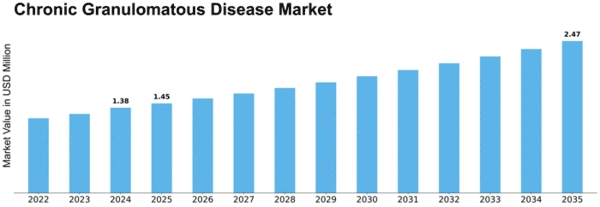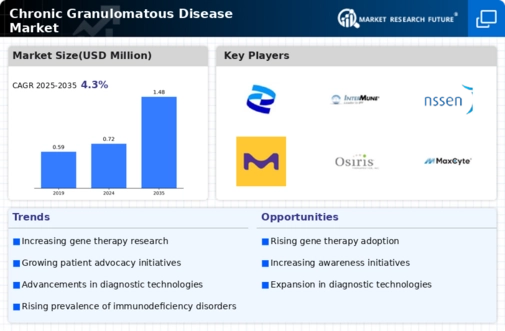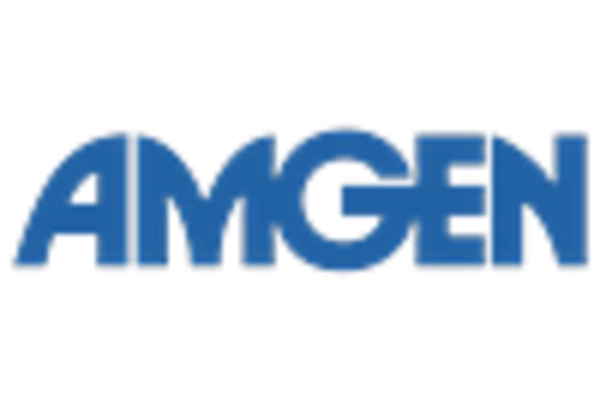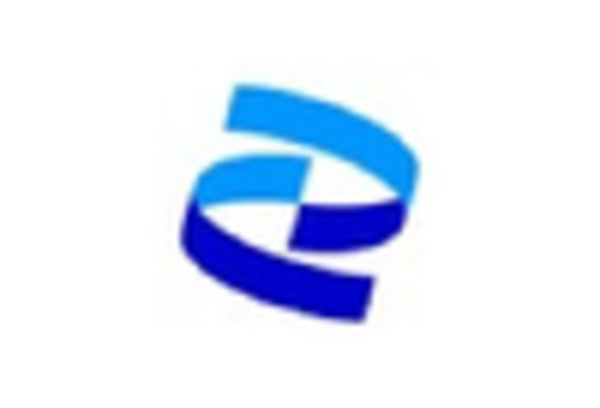-
Definition
-
Scope of the Study
- Research Objective
- Assumptions
- Limitations
-
Introduction
-
Primary Research
-
Secondary Research
-
Market Size Estimation
-
Drivers
-
Restraints
-
Opportunities
-
Challenges
-
Macroeconomic Indicators
-
Technology Trends & Assessment
-
Porter’s Five Forces Analysis
- Bargaining Power of Suppliers
- Bargaining Power of Buyers
- Threat of New Entrants
- Threat of Substitutes
- Intensity of Rivalry
-
Value Chain Analysis
-
Investment Feasibility Analysis
-
Pricing Analysis
-
Chapter 6. Global Chronic Granulomatous Disease Market, by Type
-
Introduction
-
X-Linked Chronic Granulomatous Disease
-
Market Estimates & Forecast, by Region, 2020–2027
-
Market Estimates & Forecast, by Country, 2020–2027
-
Autosomal Recessive Chronic Granulomatous Disease
-
Market Estimates & Forecast, by Region, 2020–2027
-
Market Estimates & Forecast, by Country, 2020–2027
-
Chapter 7. Global Chronic Granulomatous Disease Market, by Diagnosis
-
Introduction
-
Neutrophil Function Test
-
Market Estimates & Forecast, by Region, 2020–2027
-
Market Estimates & Forecast, by Country, 2020–2027
-
Genetic Testing
-
Market Estimates & Forecast, by Region, 2020–2027
-
Market Estimates & Forecast, by Country, 2020–2027
-
Prenatal Testing
-
Market Estimates & Forecast, by Region, 2020–2027
-
Market Estimates & Forecast, by Country, 2020–2027
-
Others
-
Chapter 8. Global Chronic Granulomatous Disease Market, by Treatment
-
Introduction
-
Infection Management
- Trimethoprim
-
Market Estimates & Forecast, by Region, 2020–2027
-
Market Estimates & Forecast, by Country, 2020–2027
-
Sulfamethoxazole
-
Market Estimates & Forecast, by Region, 2020–2027
-
Market Estimates & Forecast, by Country, 2020–2027
-
Itraconazole
-
Market Estimates & Forecast, by Region, 2020–2027
-
Market Estimates & Forecast, by Country, 2020–2027
-
Others
-
Interferon-gamma
-
Market Estimates & Forecast, by Region, 2020–2027
-
Market Estimates & Forecast, by Country, 2020–2027
-
Stem Cell Transplantation
-
Market Estimates & Forecast, by Region, 2020–2027
-
Market Estimates & Forecast, by Country, 2020–2027
-
Others
-
Chapter 9. Global Chronic Granulomatous Disease Market, by End-User
-
Introduction
-
Hospitals
-
Market Estimates & Forecast, by Region, 2020–2027
-
Market Estimates & Forecast, by Country, 2020–2027
-
Clinical Laboratory
-
Market Estimates & Forecast, by Region, 2020–2027
-
Market Estimates & Forecast, by Country, 2020–2027
-
Others
-
Chapter 10. Global Chronic Granulomatous Disease Market, by Region
-
Introduction
-
Americas
- North America
- South America
-
Europe
- Western Europe
- Eastern Europe
-
Asia-Pacific
- Japan
- China
- India
- Australia
- South Korea
- Rest of Asia-Pacific
-
Middle East & Africa
- Middle East
- Africa
-
Chapter 11. Company Landscape
-
Introduction
-
Market Share Analysis
-
Key Development & Strategies
-
Chapter 12. Company Profiles
-
Pfizer, Inc.
- Company Overview
- Product Overview
- Financials Overview
- Key Developments
- SWOT Analysis
-
InterMune, Inc.
- Company Overview
- Product Overview
- Financial Overview
- Key Developments
- SWOT Analysis
-
Novartis AG
- Company Overview
- Product Overview
- Financial Overview
- Key Development
- SWOT Analysis
-
Lonza Group
- Company Overview
- Product Overview
- Financial Overview
- Key Development
- SWOT Analysis
-
GlaxoSmithKline Plc
- Company Overview
- Product Overview
- Financial overview
- Key Developments
- SWOT Analysis
-
Eli Lily and Company
- Company Overview
- Product Overview
- Financial Overview
- Key Developments
- SWOT Analysis
-
Janssen Pharmaceuticals
- Overview
- Product Overview
- Financial Overview
- Key Developments
- SWOT Analysis
-
Merck KGaA
- Overview
- Product Overview
- Financials
- Key Developments
- SWOT Analysis
-
Osiris Therapeutics, Inc.
- Overview
- Product Overview
- Financials
- Key Developments
- SWOT Analysis
-
JCR Pharmaceuticals Co., Ltd
- Overview
- Product Overview
- Financials
- Key Developments
- SWOT Analysis
-
Maxcyte, Inc.
- Overview
- Product Overview
- Financials
- Key Developments
- SWOT Analysis
-
Horizon Pharma Plc
- Overview
- Product Overview
- Financials
- Key Developments
- SWOT Analysis
-
Others
-
Chapter 13 MRFR Conclusion
-
Key Findings
- From CEO’s Viewpoint
- Unmet Needs of the Market
-
Key Companies to Watch
-
Predictions for the Chronic Granulomatous Disease Industry
-
Chapter 14. Appendix
-
-
LIST OF TABLES
-
Global Chronic Granulomatous Disease Market Synopsis, 2020–2027
-
Global Chronic Granulomatous Disease Market Estimates and Forecast, 2020–2027
-
(USD Million)
-
Global Chronic Granulomatous Disease Market, by Region, 2020–2027 (USD Million)
-
Global Chronic Granulomatous Disease Market, by Type, 2020–2027 (USD Million)
-
Global Chronic Granulomatous Disease Market, by Diagnosis, 2020–2027 (USD Million)
-
Global Chronic Granulomatous Disease Market, by Treatment, 2020–2027(USD Million)
-
Global Chronic Granulomatous Disease Market, by End-User, 2020–2027 (USD Million)
-
North America: Chronic Granulomatous Disease Market, by Type, 2020–2027 (USD
-
Million)
-
North America: Chronic Granulomatous Disease Market, by Diagnosis, 2020–2027 (USD
-
Million)
-
North America: Chronic Granulomatous Disease Market, by Treatment, 2020–2027 (USD
-
Million)
-
North America: Chronic Granulomatous Disease Market, by End-User, 2020–2027 (USD
-
Million)
-
US: Chronic Granulomatous Disease Market, by Type, 2020–2027 (USD Million)
-
US: Chronic Granulomatous Disease Market, by Diagnosis, 2020–2027 (USD Million)
-
US: Chronic Granulomatous Disease Market, by Treatment, 2020–2027 (USD Million)
-
US: Chronic Granulomatous Disease Market, by End-User, 2020–2027 (USD Million)
-
Canada: Chronic Granulomatous Disease Market, by Type, 2020–2027 (USD Million)
-
Canada: Chronic Granulomatous Disease Market, by Diagnosis, 2020–2027 (USD Million)
-
Canada: Chronic Granulomatous Disease Market, by Treatment, 2020–2027 (USD
-
Million)
-
Canada: Chronic Granulomatous Disease Market, by End-User, 2020–2027 (USD
-
Million)
-
South America: Chronic Granulomatous Disease Market, by Type, 2020–2027 (USD
-
Million)
-
South America: Chronic Granulomatous Disease Market, by Diagnosis, 2020–2027 (USD
-
Million)
-
South America: Chronic Granulomatous Disease Market, by Treatment, 2020–2027
-
(USD Million)
-
South America: Chronic Granulomatous Disease Market, by End-User, 2020–2027 (USD
-
Million)
-
Europe: Chronic Granulomatous Disease Market, by Type, 2020–2027 (USD Million)
-
Europe: Chronic Granulomatous Disease Market, by Diagnosis, 2020–2027 (USD Million)
-
Europe: Chronic Granulomatous Disease Market, by Treatment, 2020–2027 (USD
-
Million)
-
Europe: Chronic Granulomatous Disease Market, by End-User, 2020–2027 (USD Million)
-
Western Europe: Chronic Granulomatous Disease Market, by Type, 2020–2027
-
(USD Million)
-
Western Europe: Chronic Granulomatous Disease Market, by Diagnosis, 2020–2027
-
(USD Million)
-
Western Europe: Chronic Granulomatous Disease Market, by Treatment, 2020–2027
-
(USD Million)
-
Western Europe: Chronic Granulomatous Disease Market, by End-User, 2020–2027
-
(USD Million)
-
Eastern Europe: Chronic Granulomatous Disease Market, by Type, 2020–2027
-
(USD Million)
-
Eastern Europe: Chronic Granulomatous Disease Market, by Diagnosis, 2020–2027
-
(USD Million)
-
Eastern Europe: Chronic Granulomatous Disease Market, by Treatment, 2020–2027
-
(USD Million)
-
Eastern Europe: Chronic Granulomatous Disease Market, by End-User, 2020–2027
-
(USD Million)
-
Asia-Pacific: Chronic Granulomatous Disease Market, by Type, 2020–2027 (USD
-
Million)
-
Asia-Pacific: Chronic Granulomatous Disease Market, by Diagnosis, 2020–2027 (USD
-
Million)
-
Asia-Pacific: Chronic Granulomatous Disease Market, by Treatment, 2020–2027 (USD
-
Million)
-
Asia-Pacific: Chronic Granulomatous Disease Market, by End-User, 2020–2027 (USD
-
Million)
-
Middle East & Africa: Chronic Granulomatous Disease Market, by Type, 2020–2027
-
(USD Million)
-
Middle East & Africa: Chronic Granulomatous Disease Market, by Diagnosis, 2020–2027
-
(USD Million)
-
Middle East & Africa: Chronic Granulomatous Disease Market, by Treatment, 2020–2027
-
(USD Million)
-
Middle East & Africa: Chronic Granulomatous Disease Market, by End-User, 2020–2027
-
(USD Million)
-
LIST OF FIGURES
-
Research Process
-
Segmentation for Global Chronic Granulomatous Disease Market
-
Segmentation Market Dynamics for Global Chronic Granulomatous Disease Market
-
Global Chronic Granulomatous Disease Market Share, by Type, 2020
-
Global Chronic Granulomatous Disease Market Share, by Diagnosis, 2020
-
Global Chronic Granulomatous Disease Market Share, by Treatment, 2020
-
Global Chronic Granulomatous Disease Market Share, by End-User, 2020
-
Global Chronic Granulomatous Disease Market Share, by Region, 2020
-
North America: Chronic Granulomatous Disease Market Share, by Country, 2020
-
Europe: Chronic Granulomatous Disease Market Share, by Country, 2020
-
Asia-Pacific: Chronic Granulomatous Disease Market Share, by Country, 2020
-
Middle East & Africa: Chronic Granulomatous Disease Market Share, by Country, 2020
-
Global Chronic Granulomatous Disease Market: Company Share Analysis, 2020 (%)
-
Pfizer, Inc.: Key Financials
-
Pfizer, Inc.: Segmental Revenue
-
Pfizer, Inc.: Geographical Revenue
-
InterMune, Inc.: Key Financials
-
InterMune, Inc.: Segmental Revenue
-
InterMune, Inc.: Geographical Revenue
-
Novartis AG: Key Financials
-
Novartis AG: Segmental Revenue
-
Novartis AG: Geographical Revenue
-
Lonza Group : Key Financials
-
Lonza Group: Segmental Revenue
-
Lonza Group : Geographical Revenue
-
GlaxoSmithKline Plc: Key Financials
-
GlaxoSmithKline Plc: Segmental Revenue
-
GlaxoSmithKline Plc. Geographical Revenue
-
Eli Lily and Company: Key Financials
-
Eli Lily and Company: Segmental Revenue
-
Eli Lily and Company: Geographical Revenue
-
Janssen Pharmaceuticals: Key Financials
-
Janssen Pharmaceuticals: Segmental Revenue
-
Janssen Pharmaceuticals: Geographical Revenue
-
Merck KGaA: Key Financials
-
Merck KGaA: Segmental Revenue
-
Merck KGaA: Geographical Revenue
-
Osiris Therapeutics, Inc.: Key Financials
-
Osiris Therapeutics, Inc.: Segmental Revenue
-
Osiris Therapeutics, Inc.: Geographical Revenue
-
JCR Pharmaceuticals Co., Ltd: Key Financials
-
JCR Pharmaceuticals Co., Ltd: Segmental Revenue
-
JCR Pharmaceuticals Co., Ltd: Geographical Revenue
-
Maxcyte, Inc.: Key Financials
-
Maxcyte, Inc.: Segmental Revenue
-
Maxcyte, Inc.: Geographical Revenue
-
Horizon Pharma Plc: Key Financials
-
Horizon Pharma Plc: Segmental Revenue
-
Horizon Pharma Plc: Geographical Revenue


















Leave a Comment